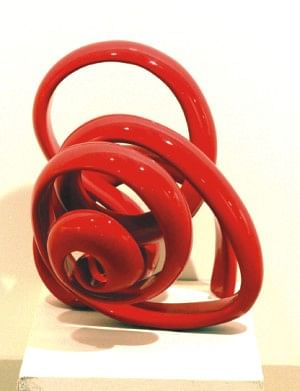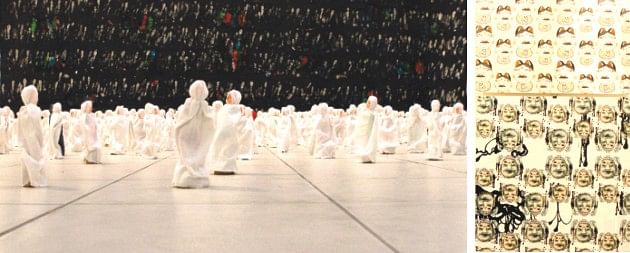|
Art
Crossing Boundaries
Rifat Munim
Photos: Zahedul I Khan

Top and bottom Shulekha Chowdhury, Life behind Life, installation, Bangladesh.
The history of art has always been one of sharing and exchanging ideas. Whenever budding artists find the existing forms and techniques inadequate to articulate their exuberant thoughts, they look up to the foreign lands, encompassing thereby a variety of local and foreign influences in the process of building a new form. But when the exchange takes place within the countries of the same continent, it takes on quite a new look.
The new look rests not only on the diversities of the art forms given the marked differences steeped in the cultures of the various countries, but also on the similarities that are common to most of the Asian countries in an era when the world of art is underscored by a growing consciousness of brushing aside all that is Eurocentric and embracing all that is indigenous to a particular culture. This was precisely manifest in the 14th Asian Art Biennale Bangladesh 2010, which now stands for the confluence of the Asian artists and seeks to redefine the 'Orient' not from the looking glass of the west, but from the critical perspective of a revived past now stripped of its colonial legacy.
Since forms and techniques in art are reflective of the history of a country, artworks displayed in the exhibition, in some way or other, echo the social and political unrest of the respective countries. Some artworks, on the other hand, manipulate the traditional art forms reinforcing the centuries-old heritage of the country. In keeping with the rapidly changing political scene and social realities, the exhibition also sees a boost in exhibiting newer art forms and techniques ranging from drawings and paintings to various installations including video presentations and CAD (computer aided design).

A viewer looks at the grand prize winning 'Point of View' by Bangladeshi artist Mohammad Wahiduzzaman.
For those accustomed to popping in the local art exhibitions, the biennale will surely be a soothing experience offering illuminating artworks, which are not characterised by unnecessary abstractions as one finds them copiously in the local art scene. Take the painting 'After Earthquake' by the Chinese artist Lin Xiaomin, which shows three hands sticking out from debris, one of those holding a pencil while the other two placing their fingers on the edge of a written paper. Or for that matter the Iranian artwork 'Dialogue Among Traditions' by Aneh Mohammad Tarari, which presents a black cloth speckled with slightly white and red streaks. An army of small dolls clothed in white are shown to be marching toward the cloth implying the Sufi philosophy that all mankind spawns from the same source negating thus the constructed differences of race, gender and class.
Then there is the intriguing painting 'Meditation with Horse' by the Nepalese painter Roshan Pradhan. Inspired by expressionism, it juxtaposes a meditating human figure resembling Budhha with the gruesome figure of a horse. The Sinhalese painter Chaminda Gomage's 'Woman 1' deconstructs the female figure into several split body parts conveying the shattered selves of a woman. The impressionistic zeal in Turkish painter Mustafa Salim Aktug's 'Happiness' is another instance of a figurative work, which attracted many viewers, offering a simplistic interpretation.
 |
 |
Chaminda Gomazefrom, Woman 1, 2, 3, Sri Lanka. |
Debashis Pal, Reflection of Time, Bangladesh. |
But what takes one by surprise is the absorbing set of sculptures and installations placed at the entrance of the National Art Gallery. Among these, the prize-winning ones rightly stand out for their sheer brilliance. The grand prize winning colossal installation 'Point of View' by the Bangladeshi artist Mohammad Wahiduzzaman is hung at the right wall of the entrance of the gallery. The artwork is made up of 90 small circles some of which showcase political figures – veteran or controversial, such as Che Guevara and Mahmoud Ahmadinejad, and pre-eminent literary figures such as Kazi Nazrul Islam. But some of the circles depict distorted human figures of various sorts in a glaring manner. As the viewer looks at it, he is faced with a myriad of apparently contradictory images where one is lost in the plurality of perspectives in the absence of an absolute one.
Korean artist Gilwoo Lee's artwork 'Dancer in Nature 001' and Japanese artist Kohei Nawa's sculpture 'Untitled' also won the grand prize. Lee's work - done in Korean paper, soldering iron, colouring and colouring paste, and coating - superimposes a dancing female figure upon a female face. Kohei's sculpture, done in mixed media, uses toys and figures purchased in Dhaka and dresses those with a heavy coating of foamed polyurethane. The outer coating serves not to trap the object inside, but to assume the shape of the outer skin, which enables the viewers to establish a point of contact with the real object.
Among the Honourable Mention Award winners, works of the four Bangladeshi artists including Mihir Moshiur Rahman and Niloofar Chaman feature installations while Joaquin Gasgonia Palencia from Philippines comes up with a spiralling sculpture in poly chromed metal and Yousuf Ahmad al Homaid from Qatar presents a riveting Arabic calligraphy.
 |
 |
Gilwoo Lee, Dancer in Nature 100, Republic of Korea. |
Honourable Mention Award winning 'Red Udon' by Joaquin Gasgonia Palencia from Philippines. |
Installations seem to have dominated the Bangladeshi artists in matters of choosing the medium. Apart from the award winning works, a good number of quite stunning installations have made their way into the exhibition. Among many others, Sulekha Chowdhury's 'Life behind Life' seeks to unearth the brutalities faced by the female garment workers in Bangladesh. Her work is surrounded by a blue cloth inside which is placed a tailoring machine, one side of it wearing the agonising mask of a female countenance. The floor has all sorts of cut cloth pieces scattered while the upper space has many scissors hanging. The agonising female mask symbolises the anguish of garment workers.
The biennale, which came into being in 1981 with only 14 countries participating, has come a long way drawing more and more countries to its ever-expanding convergence. This year it showcases about 300 artworks featuring artists from 26 Asian countries including Bahrain, China, India, Iran, Japan, Jordan, Lebanon, Malaysia, Maldives, Nepal, Republic of Korea, Qatar, Saudi Arabia, Sri Lanka, Philippines, Turkey, United Arab Emirates and Uzbekistan.

L-R: Aneh Mohammad Tarari, Dialogue among Traditions, Iran. Elif Varo Eroen, No Space 3, Turkey.
The biennale paves the way for all up and coming artists to interact with the prevalent trends of the Asian countries. It also gives them a chance for critically assessing the existing trends of their respective countries. More importantly, this grand occasion demonstrates once again that the sheer heterogeneity of Asia can hardly be contained in the essentialising term of the 'Orient', even though there is something that blurs the differences and places all the countries under an identical artistic platform.
Copyright
(R) thedailystar.net 2010 |
| |
